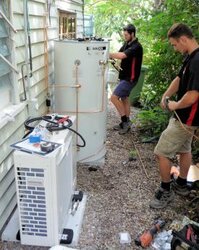I need to see more data before I jump on the split HPWH bandwagon....I'm still agnostic. It seems like I will get better COP from a semi-conditioned space than an outdoor space (requiring defrost 4-5 mos a year)...you just need a suitable 'semi-conditioned' space from which to recover a little heat that would otherwise be lost. They seem pretty common in older US homes.
In a way, a HPWH in an unconditioned basement is sort of like a hybrid geothermal system that also scavenges part of your heat loss through your floor insulation.
The flip side of defrosts for an outdoor unit in the winter is that in the summer it benefits from the warmer outside air compared to your basement. There's pros and cons to either of these options, and they depend in part on your climate.
And then there were prominent blog posts that centered on the heat stealing issue....saying that you would have to pay twice for every BTU, so it was actually more expensive than a conventional electric.
You do pay twice in the winter, but only once in the summer (potentially less, see examples), and even in the winter, depending on your source of space heat, you might not be paying anywhere near full price either time.
Here's a bunch of napkin math comparisons, assuming 70 deg F (39 deg C) temperature change to your water, where I refer to electric resistance heat as "full price":
- Winter or Summer, electric resistance DHW and electric resistance space heat: 0.171 kWh / gal water + 0 kWh makeup space heat =
0.171 kWh / gal total
- *Winter, HPWH (2.5 EF) and electric resistance space heat: 0.069 kWh / gal water + 0.171 kWh makeup space heat - 0.069 kWh waste heat =
0.171 kWh / gal total
- *Summer, HPWH (2.5 EF) and no heat: 0.069 kWh / gal water + 0 kWh makeup space heat =
0.069 kWh / gal total
- **Summer, HPWH (2.5 EF) and air conditioning (10 SEER): 0.069 kWh / gal water - 0.054 kWh makeup cooling =
0.015 kWh / gal total
- Winter, HPWH (2.5 EF) and heat pump (9 HSPF): 0.069 kWh / gal water + 0.065 kWh makeup space heat =
0.134 kWh / gal total
- ***Winter, HPWH (2.5 EF) and wood stove: 0.069 kWh / gal water + 0.071 "kWh" makeup space heat =
0.140 kWh / gal total
* Even if your effective heating season is fully half the year, you still come out slightly ahead averaging these two (0.120 kWh/gal year round), but probably not enough to justify the higher cost. Milder climates do better. Warm climates do great. Edited per Woodgeek's point that the HPWH waste heat either goes into the water, or into the space.
** Take note of the minus sign. We paid less than full price to heat the water
and paid less than full price to air condition the house, and now we're at 1/10th the summer baseline cost
*** Wood usage compared to electricity usage based on cost @ $200/cord, 20mmBTU/cord burned at 75% efficiency, $0.11/kWh
If I also calculated an example with natural gas heat, it would work out in a similar ballpark to the wood heat example, but if you have natural gas space heat, you probably also have a natural gas water heater, and it will be harder to achieve a cost savings by switching to a HPWH because natural gas is relatively cheap as a heat source.




 !
!
